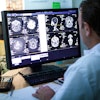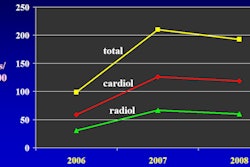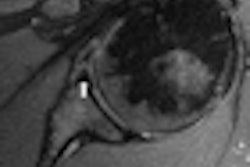A new study has found that nonradiologist ownership of advanced imaging equipment is commonplace in the U.S., with one in six physicians reporting that their practice either owned or leased imaging scanners.
The Center for Studying Health System Change (HSC) of Washington, DC, said its study is unique in focusing broadly on ownership of advanced imaging equipment rather than on specific healthcare services. The data indicate that policymakers may want to reconsider the in-office exemption to the Stark anti-self-referral law, which enables nonradiologist physicians to own and operate imaging equipment in their offices.
HSC researchers asked physicians whether they owned or leased medical equipment as part of its 2008 Health Physician Tracking Survey, a mail survey of U.S. physicians working at least 20 hours per week in direct patient care. The survey sample was limited to 2,750 physicians practicing in community-based, physician-owned settings. Physicians who practiced in hospital-based settings or who were employed by hospitals were excluded.
They reported ownership of medical equipment by the type of devices being used, as well as according to physician practice size and specialty. Among the survey's findings:
- Among all physicians, one in six respondents (17.4%) reported that they owned or leased advanced imaging equipment.
- For basic x-ray equipment, 22.7% of all physicians reported owning or leasing equipment.
- Ownership of advanced imaging equipment was highest among surgical specialists: 30.3% reported owning equipment. That compares to 15.7% of procedure-based medical specialists such as cardiologists, 13.5% of nonprocedure-based medical specialists such as neurologists, and 10.6% of adult primary care physicians.
- Ownership varied by the size of the physician practice, from a high of 52.9% of groups larger than 51 physicians owning advanced imaging equipment, to a low of 6.7% for solo practitioners.
The report went on to note that Congress and the U.S. Centers for Medicare and Medicaid Services (CMS) have made physician ownership of advanced imaging less attractive by cutting Medicare reimbursement. Also, the healthcare reform law passed earlier in 2010 includes provisions that as of January 1, 2011, will require self-referring physicians to disclose their financial interests to patients and to provide them with a list of alternative service providers.
"Given the growing evidence that physician self-referral contributes to unnecessary and costly care, policymakers might reconsider the broadness of the in-office ancillary service exemption to the Stark law," the report states. "Ultimately, moving away from fee-for-service payment toward payment mechanisms that reimburse physicians for a broader unit of service, such as an episode of care, or putting physicians at least partially at risk for the cost of care will alter the financial incentives that now encourage physician self-referrals."
By Brian Casey
AuntMinnie.com staff writer
December 28, 2010
Related Reading
Health Affairs articles explode self-referral myths, December 8, 2010
Self-referral by nonradiologists continues to drive imaging use rates, November 17, 2010
Self-employed urologists order more imaging, November 9, 2010
GAO numbers overstate growth in medical imaging, May 4, 2010
GAO takes on self-referral study, April 29, 2010
Copyright © 2010 AuntMinnie.com



















